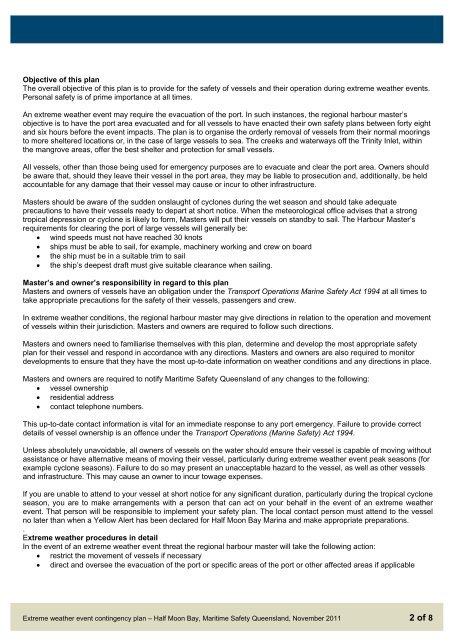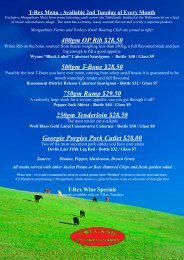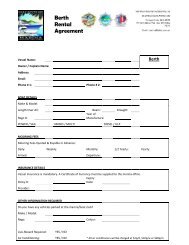Half Moon Bay Marina Cyclone Contingency Plan - Yorkeys Knob ...
Half Moon Bay Marina Cyclone Contingency Plan - Yorkeys Knob ...
Half Moon Bay Marina Cyclone Contingency Plan - Yorkeys Knob ...
You also want an ePaper? Increase the reach of your titles
YUMPU automatically turns print PDFs into web optimized ePapers that Google loves.
Objective of this plan<br />
The overall objective of this plan is to provide for the safety of vessels and their operation during extreme weather events.<br />
Personal safety is of prime importance at all times.<br />
An extreme weather event may require the evacuation of the port. In such instances, the regional harbour master’s<br />
objective is to have the port area evacuated and for all vessels to have enacted their own safety plans between forty eight<br />
and six hours before the event impacts. The plan is to organise the orderly removal of vessels from their normal moorings<br />
to more sheltered locations or, in the case of large vessels to sea. The creeks and waterways off the Trinity Inlet, within<br />
the mangrove areas, offer the best shelter and protection for small vessels.<br />
All vessels, other than those being used for emergency purposes are to evacuate and clear the port area. Owners should<br />
be aware that, should they leave their vessel in the port area, they may be liable to prosecution and, additionally, be held<br />
accountable for any damage that their vessel may cause or incur to other infrastructure.<br />
Masters should be aware of the sudden onslaught of cyclones during the wet season and should take adequate<br />
precautions to have their vessels ready to depart at short notice. When the meteorological office advises that a strong<br />
tropical depression or cyclone is likely to form, Masters will put their vessels on standby to sail. The Harbour Master’s<br />
requirements for clearing the port of large vessels will generally be:<br />
wind speeds must not have reached 30 knots<br />
ships must be able to sail, for example, machinery working and crew on board<br />
the ship must be in a suitable trim to sail<br />
the ship’s deepest draft must give suitable clearance when sailing.<br />
Master’s and owner’s responsibility in regard to this plan<br />
Masters and owners of vessels have an obligation under the Transport Operations Marine Safety Act 1994 at all times to<br />
take appropriate precautions for the safety of their vessels, passengers and crew.<br />
In extreme weather conditions, the regional harbour master may give directions in relation to the operation and movement<br />
of vessels within their jurisdiction. Masters and owners are required to follow such directions.<br />
Masters and owners need to familiarise themselves with this plan, determine and develop the most appropriate safety<br />
plan for their vessel and respond in accordance with any directions. Masters and owners are also required to monitor<br />
developments to ensure that they have the most up-to-date information on weather conditions and any directions in place.<br />
Masters and owners are required to notify Maritime Safety Queensland of any changes to the following:<br />
vessel ownership<br />
residential address<br />
contact telephone numbers.<br />
This up-to-date contact information is vital for an immediate response to any port emergency. Failure to provide correct<br />
details of vessel ownership is an offence under the Transport Operations (Marine Safety) Act 1994.<br />
Unless absolutely unavoidable, all owners of vessels on the water should ensure their vessel is capable of moving without<br />
assistance or have alternative means of moving their vessel, particularly during extreme weather event peak seasons (for<br />
example cyclone seasons). Failure to do so may present an unacceptable hazard to the vessel, as well as other vessels<br />
and infrastructure. This may cause an owner to incur towage expenses.<br />
If you are unable to attend to your vessel at short notice for any significant duration, particularly during the tropical cyclone<br />
season, you are to make arrangements with a person that can act on your behalf in the event of an extreme weather<br />
event. That person will be responsible to implement your safety plan. The local contact person must attend to the vessel<br />
no later than when a Yellow Alert has been declared for <strong>Half</strong> <strong>Moon</strong> <strong>Bay</strong> <strong>Marina</strong> and make appropriate preparations.<br />
.<br />
Extreme weather procedures in detail<br />
In the event of an extreme weather event threat the regional harbour master will take the following action:<br />
restrict the movement of vessels if necessary<br />
direct and oversee the evacuation of the port or specific areas of the port or other affected areas if applicable<br />
Extreme weather event contingency plan – <strong>Half</strong> <strong>Moon</strong> <strong>Bay</strong>, Maritime Safety Queensland, November 2011 2 of 8






